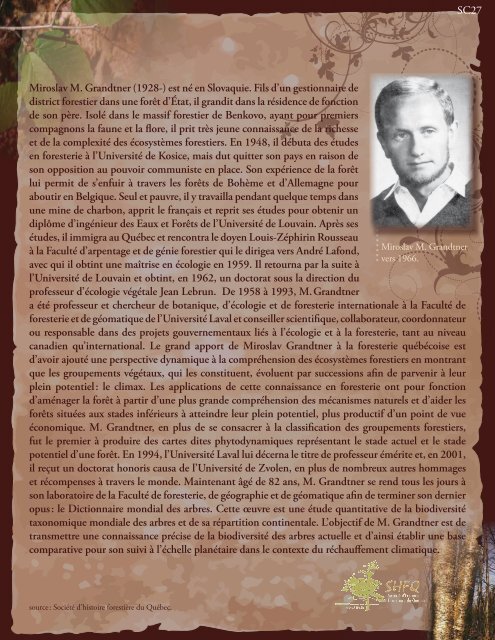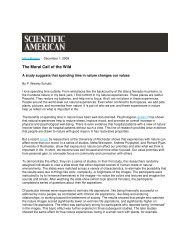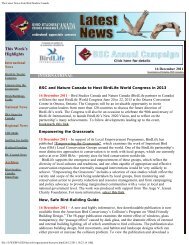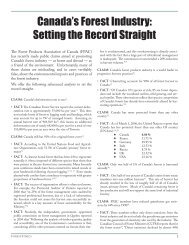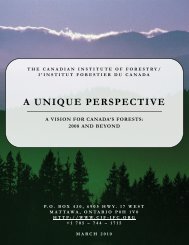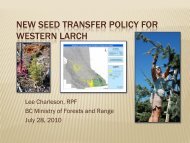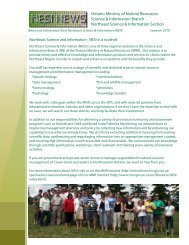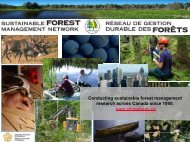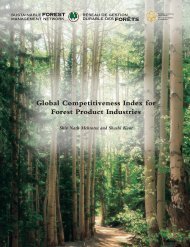Le 30 mai 1919, le ministère des Terres et Forêts décida de ...
Le 30 mai 1919, le ministère des Terres et Forêts décida de ...
Le 30 mai 1919, le ministère des Terres et Forêts décida de ...
- No tags were found...
You also want an ePaper? Increase the reach of your titles
YUMPU automatically turns print PDFs into web optimized ePapers that Google loves.
SC27Miroslav M. Grandtner (1928-) est né en Slovaquie. Fils d’un gestionnaire <strong>de</strong>district forestier dans une forêt d’État, il grandit dans la rési<strong>de</strong>nce <strong>de</strong> fonction<strong>de</strong> son père. Isolé dans <strong>le</strong> massif forestier <strong>de</strong> Benkovo, ayant pour premierscompagnons la faune <strong>et</strong> la flore, il prit très jeune connaissance <strong>de</strong> la richesse<strong>et</strong> <strong>de</strong> la comp<strong>le</strong>xité <strong><strong>de</strong>s</strong> écosystèmes forestiers. En 1948, il débuta <strong><strong>de</strong>s</strong> étu<strong><strong>de</strong>s</strong>en foresterie à l’Université <strong>de</strong> Kos ice, <strong>mai</strong>s dut quitter son pays en raison <strong><strong>de</strong>s</strong>on opposition au pouvoir communiste en place. Son expérience <strong>de</strong> la forêtlui permit <strong>de</strong> s’enfuir à travers <strong>le</strong>s forêts <strong>de</strong> Bohème <strong>et</strong> d’Al<strong>le</strong>magne pouraboutir en Belgique. Seul <strong>et</strong> pauvre, il y travailla pendant quelque temps dansune mine <strong>de</strong> charbon, apprit <strong>le</strong> français <strong>et</strong> reprit ses étu<strong><strong>de</strong>s</strong> pour obtenir undiplôme d’ingénieur <strong><strong>de</strong>s</strong> Eaux <strong>et</strong> Forêts <strong>de</strong> l’Université <strong>de</strong> Louvain. Après sesétu<strong><strong>de</strong>s</strong>, il immigra au Québec <strong>et</strong> rencontra <strong>le</strong> doyen Louis-Zéphirin Rousseauà la Faculté d’arpentage <strong>et</strong> <strong>de</strong> génie forestier qui <strong>le</strong> dirigea vers André Lafond,avec qui il obtint une maîtrise en écologie en 1959. Il r<strong>et</strong>ourna par la suite àl’Université <strong>de</strong> Louvain <strong>et</strong> obtint, en 1962, un doctorat sous la direction duprofesseur d’écologie végéta<strong>le</strong> Jean <strong>Le</strong>brun. De 1958 à 1993, M. GrandtnerMiroslav M. Grandtnervers 1966.a été professeur <strong>et</strong> chercheur <strong>de</strong> botanique, d’écologie <strong>et</strong> <strong>de</strong> foresterie internationa<strong>le</strong> à la Faculté <strong>de</strong>foresterie <strong>et</strong> <strong>de</strong> géomatique <strong>de</strong> l’Université Laval <strong>et</strong> conseil<strong>le</strong>r scientifique, collaborateur, coordonnateurou responsab<strong>le</strong> dans <strong><strong>de</strong>s</strong> proj<strong>et</strong>s gouvernementaux liés à l’écologie <strong>et</strong> à la foresterie, tant au niveaucanadien qu’international. <strong>Le</strong> grand apport <strong>de</strong> Miroslav Grandtner à la foresterie québécoise estd’avoir ajouté une perspective dynamique à la compréhension <strong><strong>de</strong>s</strong> écosystèmes forestiers en montrantque <strong>le</strong>s groupements végétaux, qui <strong>le</strong>s constituent, évoluent par successions afin <strong>de</strong> parvenir à <strong>le</strong>urp<strong>le</strong>in potentiel : <strong>le</strong> climax. <strong>Le</strong>s applications <strong>de</strong> c<strong>et</strong>te connaissance en foresterie ont pour fonctiond’aménager la forêt à partir d’une plus gran<strong>de</strong> compréhension <strong><strong>de</strong>s</strong> mécanismes naturels <strong>et</strong> d’ai<strong>de</strong>r <strong>le</strong>sforêts situées aux sta<strong><strong>de</strong>s</strong> inférieurs à atteindre <strong>le</strong>ur p<strong>le</strong>in potentiel, plus productif d’un point <strong>de</strong> vueéconomique. M. Grandtner, en plus <strong>de</strong> se consacrer à la classification <strong><strong>de</strong>s</strong> groupements forestiers,fut <strong>le</strong> premier à produire <strong><strong>de</strong>s</strong> cartes dites phytodynamiques représentant <strong>le</strong> sta<strong>de</strong> actuel <strong>et</strong> <strong>le</strong> sta<strong>de</strong>potentiel d’une forêt. En 1994, l’Université Laval lui décerna <strong>le</strong> titre <strong>de</strong> professeur émérite <strong>et</strong>, en 2001,il reçut un doctorat honoris causa <strong>de</strong> l’Université <strong>de</strong> Zvo<strong>le</strong>n, en plus <strong>de</strong> nombreux autres hommages<strong>et</strong> récompenses à travers <strong>le</strong> mon<strong>de</strong>. Maintenant âgé <strong>de</strong> 82 ans, M. Grandtner se rend tous <strong>le</strong>s jours àson laboratoire <strong>de</strong> la Faculté <strong>de</strong> foresterie, <strong>de</strong> géographie <strong>et</strong> <strong>de</strong> géomatique afin <strong>de</strong> terminer son <strong>de</strong>rnieropus : <strong>le</strong> Dictionnaire mondial <strong><strong>de</strong>s</strong> arbres. C<strong>et</strong>te œuvre est une étu<strong>de</strong> quantitative <strong>de</strong> la biodiversitétaxonomique mondia<strong>le</strong> <strong><strong>de</strong>s</strong> arbres <strong>et</strong> <strong>de</strong> sa répartition continenta<strong>le</strong>. L’objectif <strong>de</strong> M. Grandtner est d<strong>et</strong>ransm<strong>et</strong>tre une connaissance précise <strong>de</strong> la biodiversité <strong><strong>de</strong>s</strong> arbres actuel<strong>le</strong> <strong>et</strong> d’ainsi établir une basecomparative pour son suivi à l’échel<strong>le</strong> planétaire dans <strong>le</strong> contexte du réchauffement climatique.source : Société d’histoire forestière du Québec.


